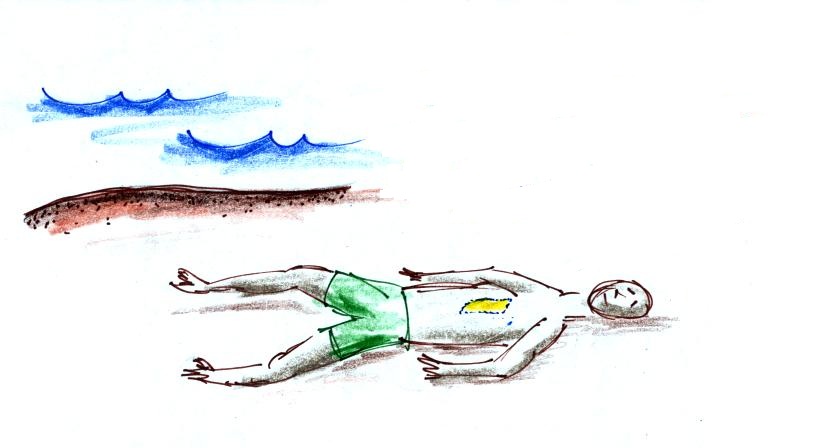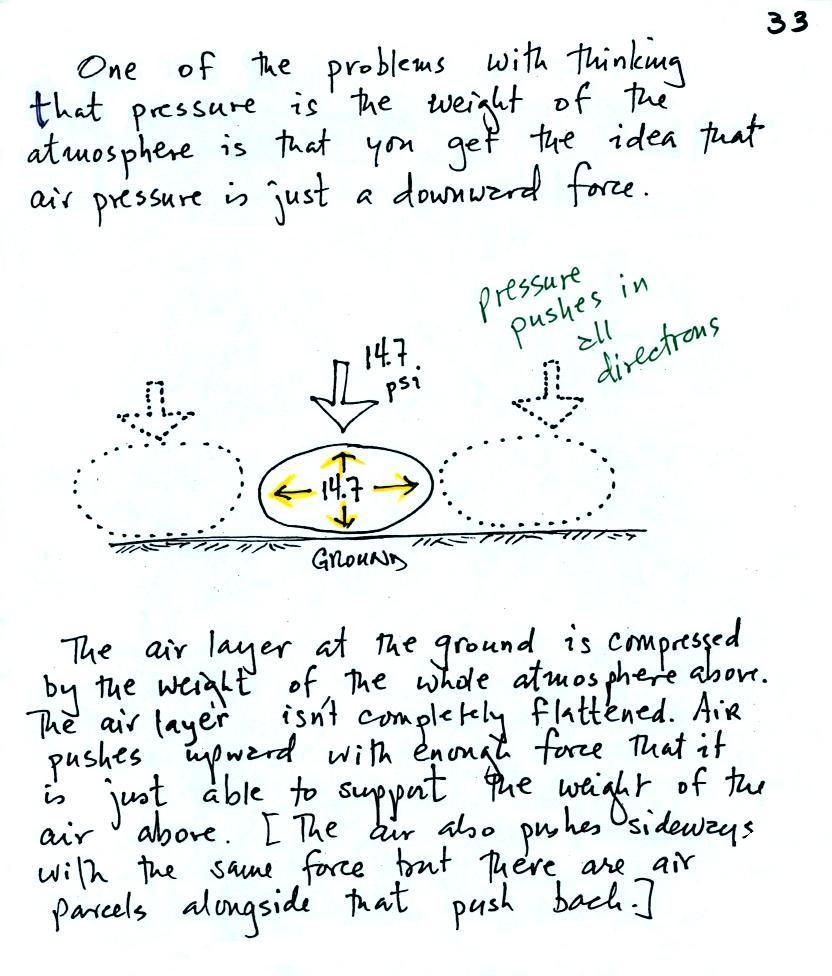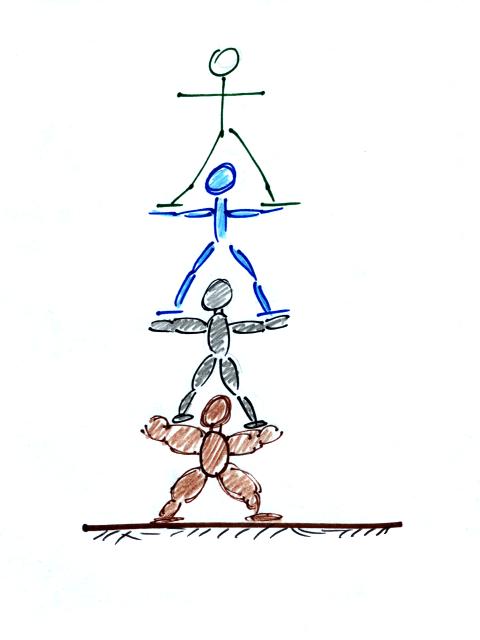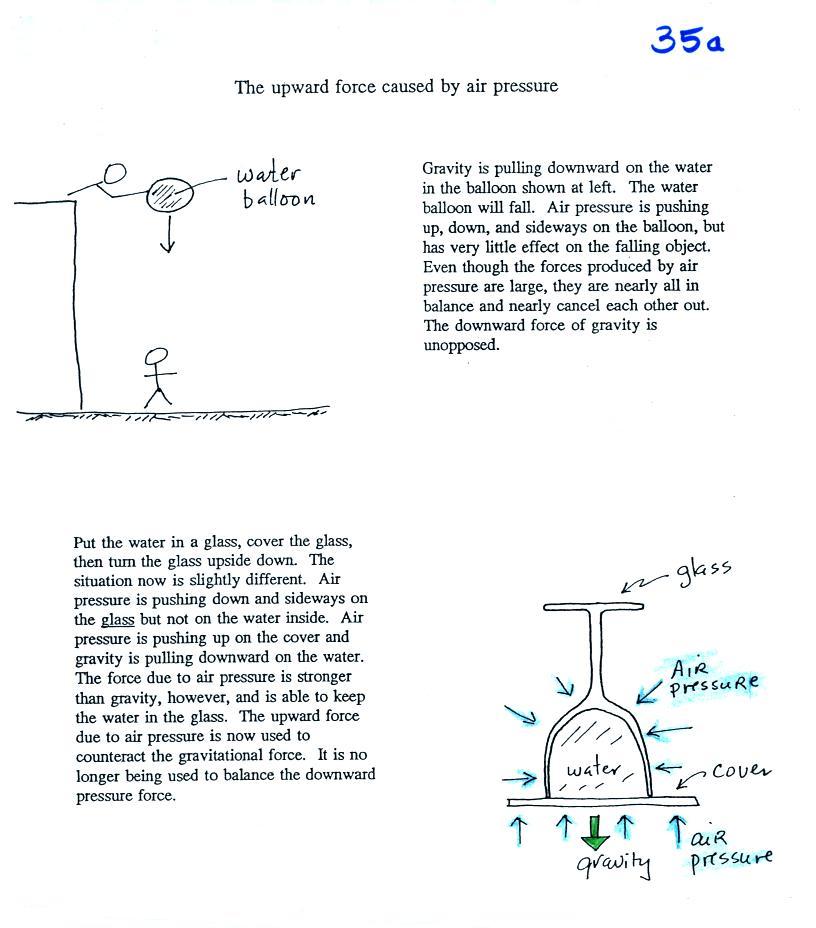Friday Jan. 25, 2013
click here to download today's notes in a
more printer friendly format
Brandi Carlile's version of "Creep"
before class this afternoon.
The 1st Optional
Assignment of the semester was collected today. I'll
have a look at them and try to get them back to you on
Monday. I'll also put some answers online, probably next
Monday.
The Practice Quiz is mostly finished and the Practice Quiz Study Guide is now in
it's final form.
Sea level pressure, 14.7 psi, might not sound like much.
But when you start to multiply 14.7 by all the square inches on
your body it turns into 1000s of pounds of weight (force).
As the picture above shows, when you're lying on the beach there
are 470 pounds of air pressing down on a brick size (4" x 8") area
of your chest.
Why isn't the person in the picture above
crushed by the weight of the atmosphere above. The
answer is that the person's body pushes back with the same
amount of force. Air does the same thing. This is
a topic that we will come back to at the end of the class
today.
And a quick question to test your understanding of density.
How could you increase the density of the air in the volume
sketched above? There are two ways. I've stuck the
answers at the end of today's notes.
A real potpourri of topics today.
This next figure (p. 26 in the
ClassNotes) explores why the rate of pressure change as
you move or down in the atmosphere depends on air
density. In particular air pressure will decrease
more quickly when you move upward through high density air
than if you move upward through low density air.
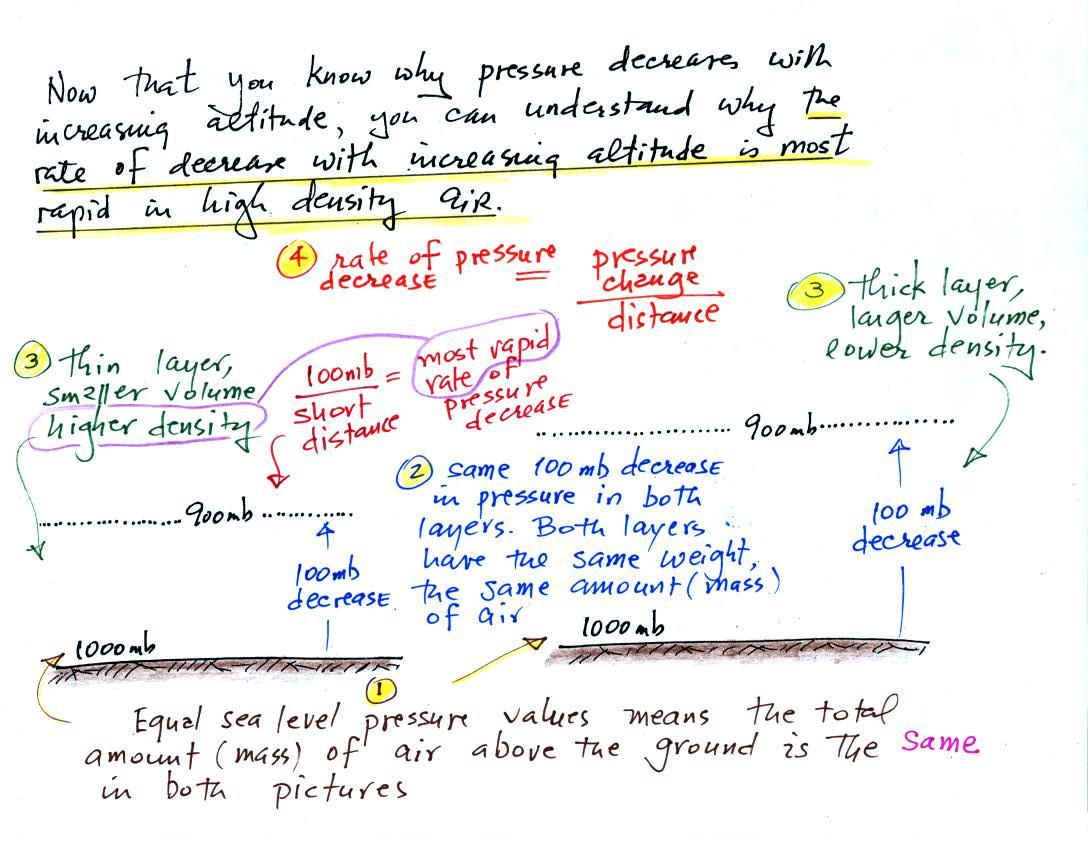
There's a lot going on in this picture, we'll examine it
step by step.
1.The sea level pressure is the same, 1000 mb, in both
pictures. Since pressure is determined by the weight of
the air overhead, the weight of the air overhead in the left
picture is the same as in the right picture. The amount
(mass) of air above sea level in both pictures is the same.
2. There is a 100 mb drop in pressure in both
air layers. Pressure has decreased because air that was
overhead (the air between the ground the level of the dotted
line) is now underneath. Because the pressure change is
the same in both pictures the weight of the air layers are the
same. The thin layer at left has the same weight as the
thicker layer at right. Both layers contain the same
amount (mass) of air.
3. Both layers contain the same amount (mass) of
air. The air in the layer at left is thinner. The
air is squeezed into a smaller volume. The air in the
layer at left is denser than the air in the layer at right.
4. To determine the rate of pressure decrease you divide
the pressure change (100 mb for both layers) by the distance
over which that change occurs. The 100 mb change takes
place in a shorter distance in the layer at left than in the
layer at right. The left layer has the highest rate of
pressure decrease with increasing altitude.
So both the most rapid rate of pressure decrease with
altitude and the densest air are found in Layer A.
The fact that the rate of pressure decrease with increasing
altitude depends on air density is a fairly subtle but
important concept. This concept will come up 2 or 3 more
times later in the semester. For example, we will need
this concept to explain why hurricanes can intensify and get
as strong as they do.
The next topic is a short
explanation of how a mercury barometer works. A mercury
barometer is used to measure atmospheric pressure and is really
just a balance that can be used to weigh the atmosphere.
You'll find a messier version of what follows on p. 29 in the
photocopied Class Notes.
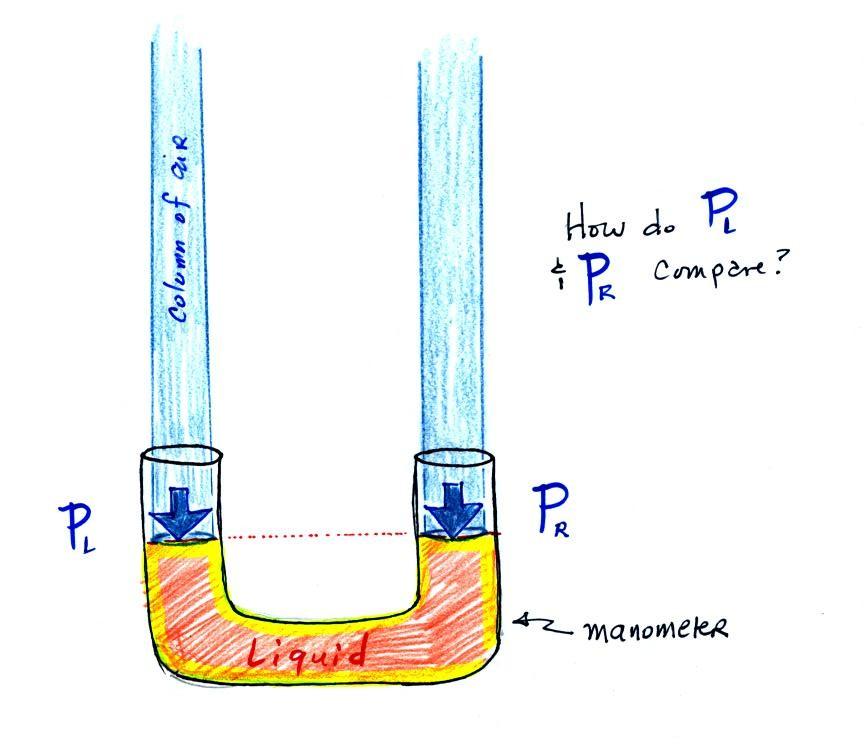 |
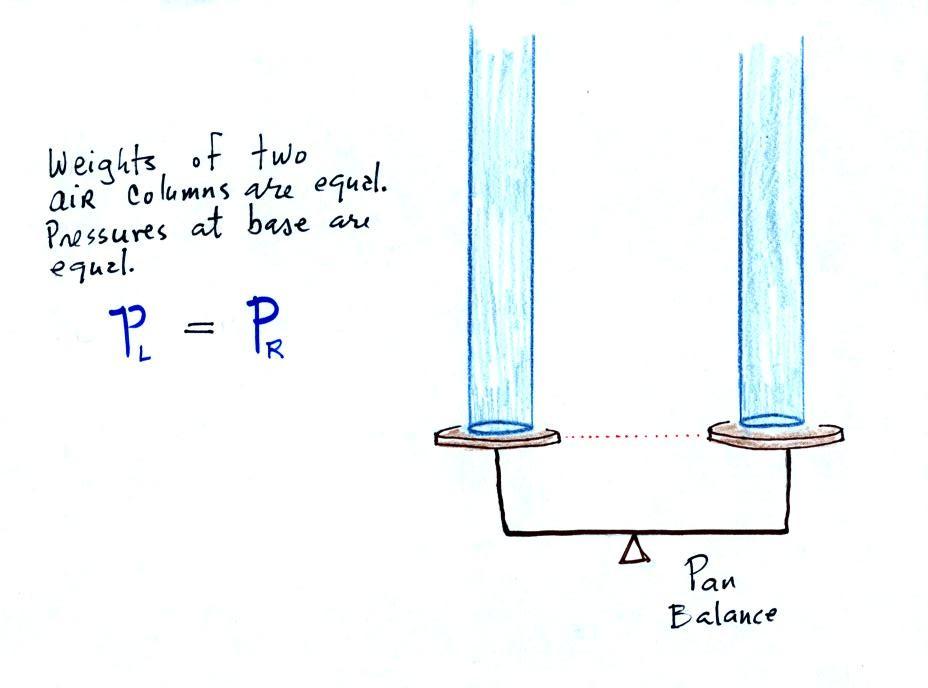
|
The instrument in the left
figure above ( a u-shaped glass tube filled with a liquid of
some kind) is actually called a manometer and can be used to
measure pressure difference.
The two ends of the tube are open so that air can get inside and
air pressure can press on the liquid. Given that the
liquid levels on the two sides of the manometer are equal,
what could you about PL
and PR?
The liquid can slosh back and forth just like
the pans on a balance can move up and down. A manometer
really behaves just like a pan balance (pictured above at right)
or a teeter totter (seesaw).
Because the two pans are in balance, the two columns of air have
the same weight. PL and PR are equal (but note that
you don't really know what either pressure is, just that they
are equal).
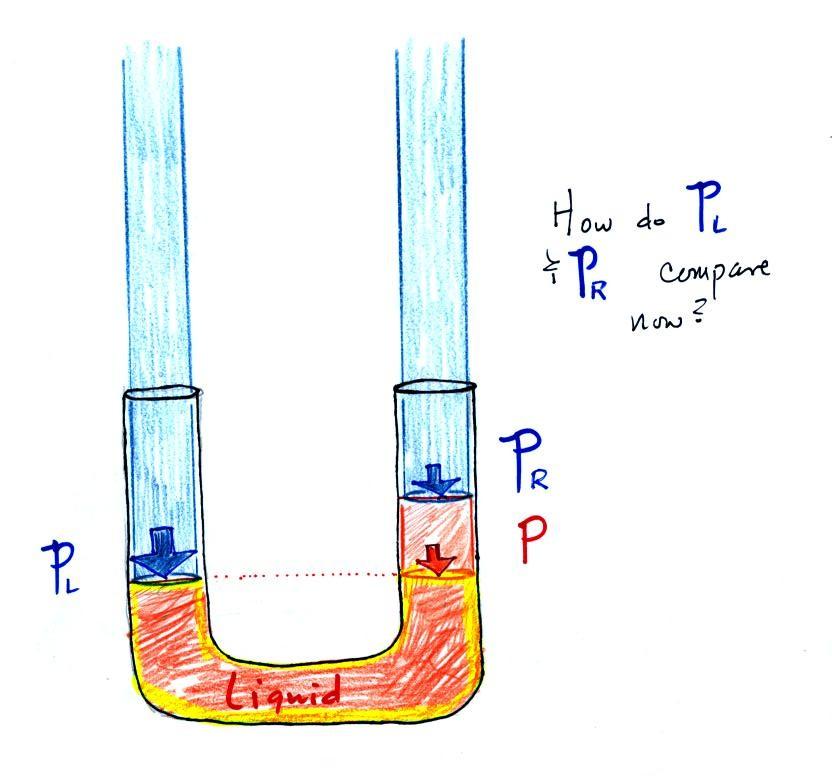 |
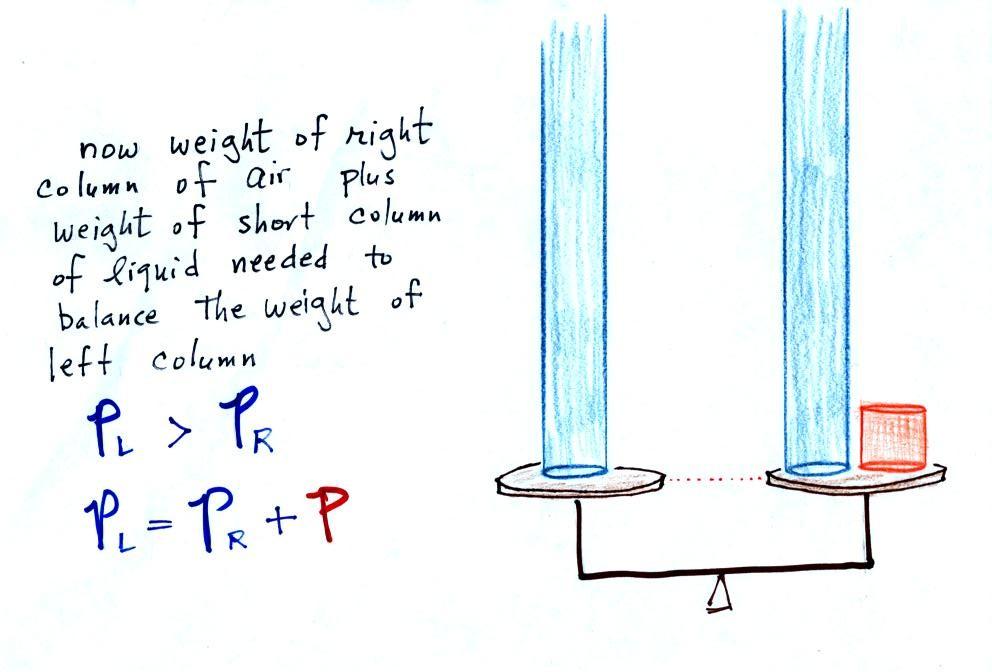
|
Now the situation is a little
different, the liquid levels are no longer equal. You
probably realize that the air pressure on the left, PL, is a little higher than
the air pressure on the right, PR.
PL is now being balanced
by PR + P acting
together. P is the pressure produced by the weight of the
extra fluid on the right hand side of the manometer (the fluid
that lies above the dotted line). The height
of the column of extra liquid provides a measure of the
difference between PL and
PR.
Next we will just go and close off the right hand side of the
manometer.
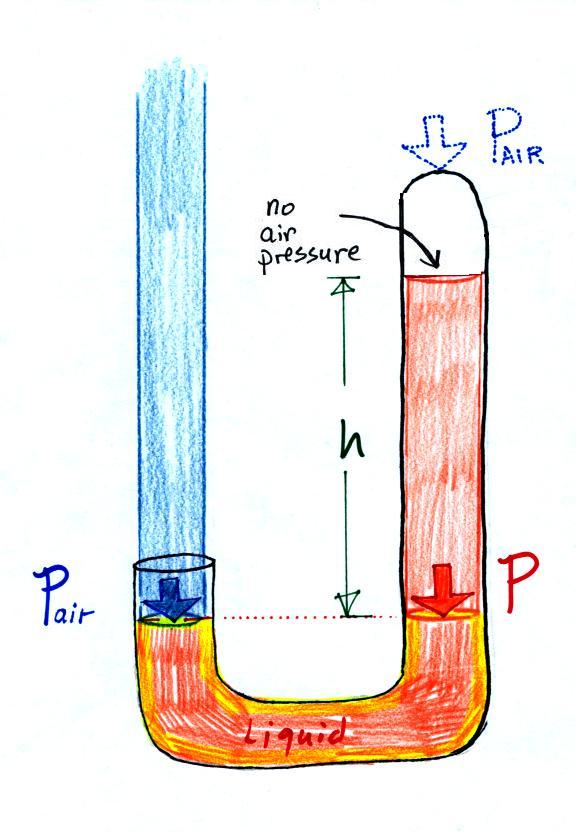
|
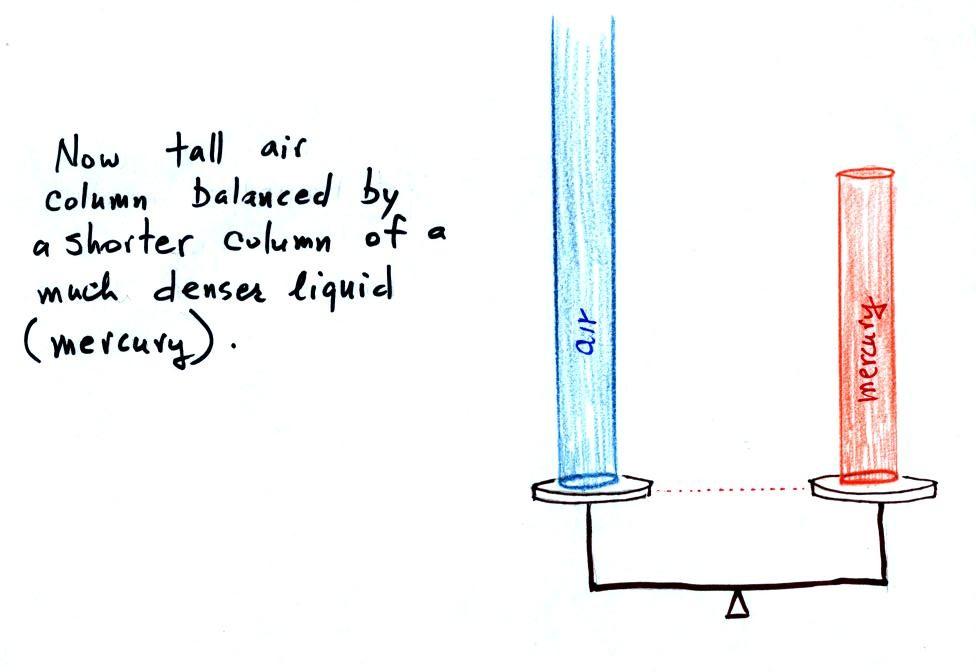
|
Air pressure can't get into the
right tube any more. Now at the level of the dotted line
the balance is between Pair
and P (pressure by the extra liquid on the right). If
Pair changes, the height
of the right column, h, will change. You now have a
barometer, an instrument that can measure and monitor the
atmospheric pressure.
Barometers like this are usually filled with mercury.
Mercury is a liquid. You need a liquid that can slosh back
and forth in response to changes in air pressure. Mercury
is also very dense which means the barometer won't need to be as
tall as if you used something like water. A water
barometer would need to be over 30 feet tall.
With mercury you will need only a 30 inch tall column to
balance the weight of the atmosphere at sea level under normal
conditions (remember the 30 inches of mercury pressure units
mentioned earlier). Mercury also has a low rate of
evaporation so you don't have much mercury gas at the top of the
right tube (there's some gas, it doesn't produce much pressure,
but it would poison you if you were to start to breath it).
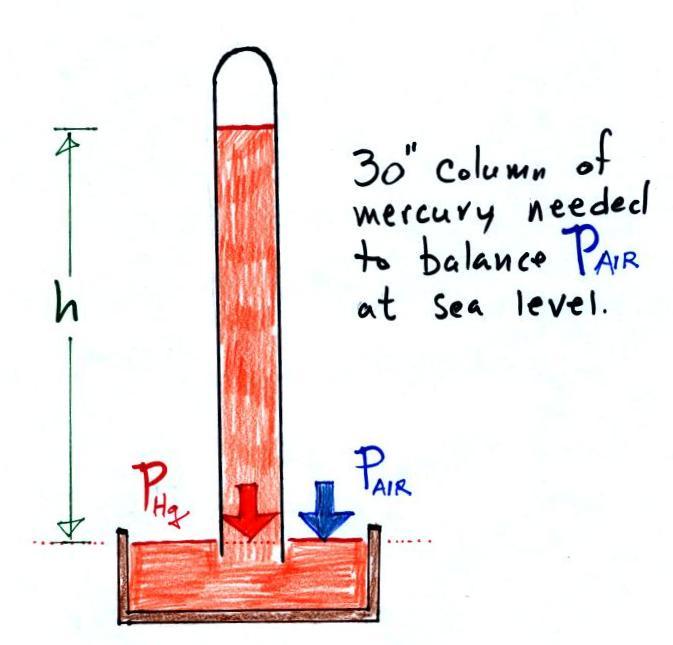
Here is a more conventional barometer design. The bowl of
mercury is usually covered in such a way that it can sense changes
in pressure but is sealed to keep poisonous mercury vapor from
filling a room.
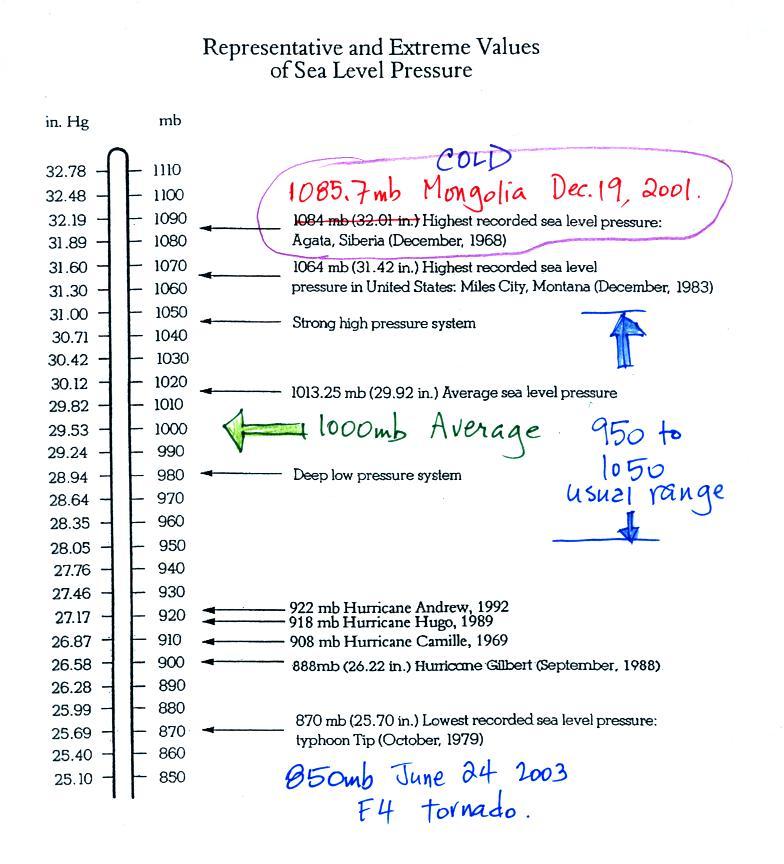
Average sea level atmospheric
pressure is about 1000 mb. The figure above (p. 30 in
the photocopied Class Notes) gives 1013.25 mb but 1000 mb is
close enough in this class. The actual pressure can be
higher or lower than this average value and usually falls
between 950 mb and 1050 mb.
The figure also includes record high and low pressure
values. Record high sea level pressure
values occur during cold weather. The TV
weather forecast will often associate hot weather with high
pressure. They are generally referring to upper level
high pressure (high pressure at some level above the ground)
rather than surface pressure.
Most of the record low pressure values have all been set by
intense hurricanes (the extreme low pressure is the reason
these storms are so intense). Hurricane Wilma in 2005
set a new record low sea level pressure reading for the
Atlantic, 882 mb. Hurricane Katrina had a pressure of
902 mb. The following table lists some of the
information on hurricane strength from p. 146a in the
photocopied ClassNotes. 3 of the 10 strongest N.
Atlantic hurricanes occurred in 2005.
Most
Intense North Atlantic Hurricanes
|
Most
Intense
Hurricanes
to hit the US Mainland
|
Wilma
(2005) 882 mb
Gilbert (1988) 888 mb
1935 Labor Day 892 mb
Rita (2005) 895 mb
Allen (1980) 899
Katrina (2005) 902
|
1935
Labor Day 892 mb
Camille (1969) 909 mb
Katrina (2005) 920 mb
Andrew (1992) 922 mb
1886 Indianola (Tx) 925 mb |
Note that a new all time record low sea level pressure was
measured in 2003 inside a strong tornado in Manchester, South
Dakota (F4 refers to the Fujita scale rating, F5 is the highest
level on the scale). This is very difficult (and very
hazardous) to do. Not only must the instruments be built to
survive a tornado but they must also be placed on the ground ahead
of an approaching tornado and the tornado must then pass over the
instruments (also the person placing the instrument needs to get
out of the area).
And now the last topic of the day.
Pressure at any level in the
atmosphere depends on (is determined by) the weight of the air
overhead. You might get the idea that pressure just pushes
downward.
Air pressure is a force that pushes downward, upward,
and sideways. If you fill a balloon with air and then push
downward on it, you can feel the air in the balloon pushing back
(pushing upward). You'd see the air in the balloon pushing
sideways as well.
We were able to see this by placing a brick on top of a
balloon. The balloon gets squished but not flattened.
It eventually pushes back with enough force to support the brick.
Another helpful representation of air in the atmosphere
might be a people pyramid.
If the bottom person in the stack above were standing on a
scale, the scale would measure the total weight of all the people
in the pile. That's analogous to sea level pressure being
determined by the weight of the all the air above.
The bottom person in the picture above must be strong enough to
support the weight of all the people above. That is
equivalent to the bottom layer of the atmosphere pushing upward
with enough pressure to support the weight of the air above.
The air pressure in the four tires on your automobile pushes
pushes upward with enough force to keep this 1000 or 2000 pound
vehicle (my own personal vehicle) off the ground. The air
pressure also pushes downward, you'd feel it if the car ran over
your foot.
This was a logical point to do a demonstration. A demo
that tries to prove that air pressure really does push upward as
well as downward. Not only that but that the upward force is
fairly strong. The demonstration is summarized on p. 35 a in
the ClassNotes.
Don't worry too much about the
details above because there's a more detailed explanation is
below.
At this point you should wonder why is it that the water in a
balloon will fall while the water in the wine glass does not.
Here's a little bit more
detailed and more complete explanation of what is going
on. First the case of a water balloon.
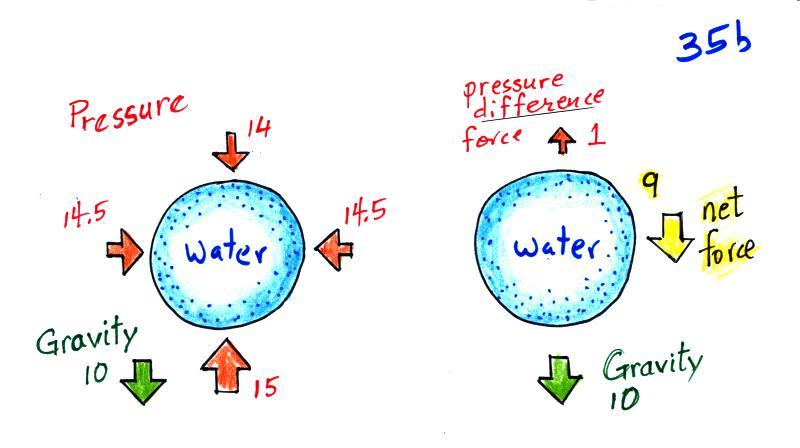
The figure at left shows air pressure (red arrows) pushing on
all the sides of the balloon. Because pressure decreases
with increasing altitude, the pressure from the air at the top
of the balloon pushing downward (strength=14) is a little weaker
than the pressure from the air at the bottom of the balloon that
is pushing upward (strength=15). The two sideways forces
cancel each other out. The total effect of the pressure is
a weak upward pressure difference force (1 unit of upward force
shown at the top of the right figure).
Gravity exerts a downward force on the water balloon. In
the figure at right you can see that the gravity force
(strength=10) is stronger than the upward pressure difference
force (strength=1). The balloon falls as a result.
This is what you know would happen if you let go of a water
balloon, it would fall.
In the demonstration a wine glass is filled with water.
A small plastic lid is used to cover the wine glass. The
wine glass is then turned upside and the water does not fall
out.
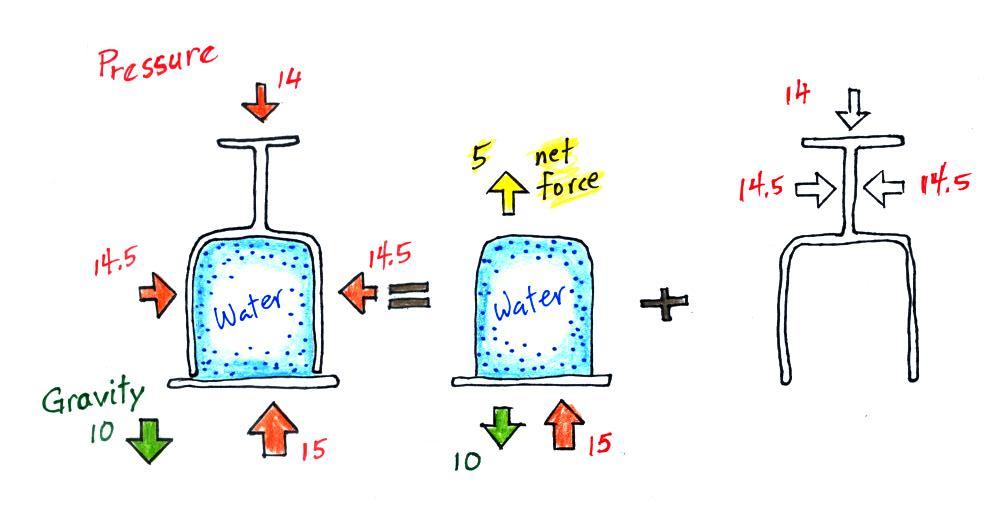
All the same forces are shown again in the left most
figure. In the right two figures we separate this into two
parts. First the water inside the glass isn't feeling the
downward and sideways pressure forces (because they're pushing on
the glass, they're included on the right figure ). Gravity
still pulls downward on the water but the upward pressure force is
able to overcome the downward pull of gravity. It can do
this because all 15 units are used to overcome gravity and not to
cancel out the downward pointing pressure force. The net
upward force is strong enough to keep the water in the glass.
The demonstration was repeated using a 4 Liter flash (more than
a gallon of water, more than 8 pounds of water). The upward
pressure force was still able to keep the water in the flask (much
of the weight of the water is pushing against the sides of the
flask which the instructor was supporting with his arms).
Here's the answer to the question about air
density near the start of today's notes

Adding air to the volume and/or decreasing
the volume would both increase the air density in the box.
